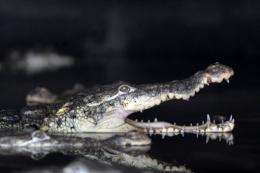Honduran crocodile farm bets on skins' glam future

Fancy a set of crocodile-hide luggage? Or luxe-look croc-skin shoes, or a croc filet? A farm in Honduras is betting on striking it rich by tending the endangered beasts until it is legal to sell them.
Cocodrilos Continentales opened in 1989 focused on, according to the company, raising American crocodiles "for commercial purposes" and—until it is no longer endangered—to help "preserve the species."
The American crocodile, known also by its scientific name Crocodylus acutus, lives in swamps and rivers in southern Florida, the Caribbean region and Venezuela, Central America and Mexico's Pacific coast down to northern Peru.
Unlike the American Alligator, a species common in the southern United States, the Crocodylus acutus has been pushed to the verge of extinction by commercial farming and hunting across most of the region. It is considered an endangered species and its commercial export is banned.
But as their numbers rise, at some point the crocs may cease to be protected. And people here think the day may be coming soon.
Cocodrilos Continentales is waiting for the day the creature is no longer endangered. When that happens, it has 10,000 crocodiles to place on the market to meet an anticipated demand for crocodile hide and meat.
The main attraction at this croc farm is Jose, a 4.5 meter-long (15 foot) beast believed to be 115 years old. Jose was captured in 1991 in the Motagua River, a river that begins in the highlands of Guatemala and flows east into the Caribbean. Its final few kilometers form the border between the two countries.
Today Jose lives safe from hunters, enjoying his ration of tilapia fish and retired from his duties as a stud. He calmly swims in a small lake covered with green scum, a peaceful existence that belies the animal's ferocity.
American crocodiles eat fish, birds and mammals that venture too close. They also can attack humans.
— A crocodile factory —
—————————————-
Cocodrilos Continentales, founded by the Rosenthals, one of the wealthiest families in Honduras, is located some 220 kilometers (135 miles) north of the Honduran capital Tegucigalpa.
It costs $1 million a year to operate the 30 hectare (75 acre) farm, manager Antonio Mejia told AFP. The money goes for salaries for its 17 employees, and food and care for the crocs.
The farm has 141 artificial lakes, mostly covered ponds the size of a mid-sized backyard swimming pool populated by a male croc and four females.
In these lakes the females "lay up to 60 eggs once a year. Each male fertilizes four females," said Mejia. If the male fails in his duties, the animal is sent into retirement.
Young crocs are then raised in special pools, and later moved to fattening ponds where they spend two years gorging on fish and meat.
The farm's current crocodile population may seem large, but US and Canadian experts "said that we should have at least 18,000 crocodiles to start exporting," Mejia told AFP.
Honduran authorities say the ban on American crocodile exports could end as early as March at an upcoming meeting of the Convention on International Trade in Endangered Species of Wild Fauna and Flora (CITES) in Bangkok.
"We have received a notification from CITES, in Geneva, that the acutus crocodile will be (reclassified) at the next meeting," the head of the Fisheries and Aquaculture Directorate, Elizabeth Gutierrez, told AFP.
The species—if declared no longer in danger of extinction—will remain protected, but after a scientific study to confirm the population has bounced back, commercial exports of farm-raised crocodiles could get the green light, Gutierrez said.
For now, Jose can keep enjoying his retirement, and tourists are welcome to visit the farm to snap pictures of the fearsome reptiles.
(c) 2012 AFP

















